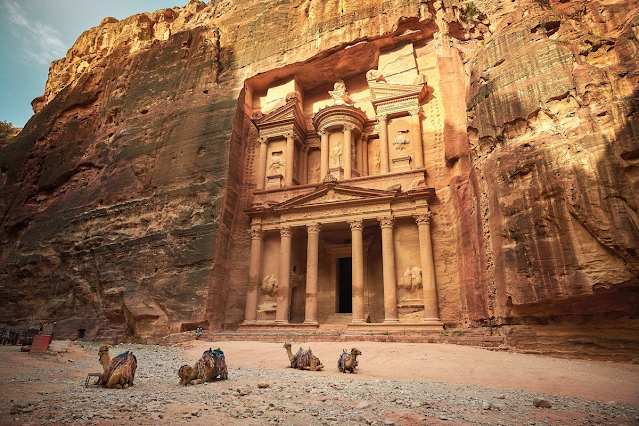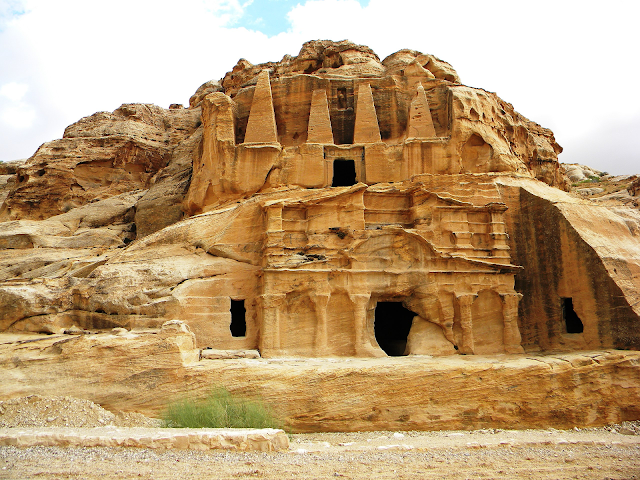Less than a mile from the theatre I arrived at the most famous ancient wonder in Petra known as Khazneh, aka The Treasury. Unlike Ad-Deir (The Monastery) that is connected to the rock behind it, The Treasury is tucked into the rock preserving its façade from prevailing winds, rain and flash floods. It is 100ft (30m) wide and 130ft (40m) tall designed in a classical style influenced by Greek and Roman architecture. Six Corinthian columns topped with a triangular pediment leads to an antechamber with three entrances – left, right and centre – that then lead into the burial chambers.
The top floor also has six columns but it is not topped with a pediment as is typical of classical architecture because the weight would have pressed on the lower floor. Instead, two half pediments are erected on either side of a circular central feature with an urn on top. It was believed that the urn contained treasure and the local Bedouin would fire their rifles at the urn in the hope that it would break and release the treasures, hence the name of the structure. However, the inside is very much tomb-like and it is likely that the story around the treasures was a fallacy.
The
forecourt of the Khazneh used to be at least 19ft (6m) lower during the
Nabatean times and before Khazneh existed there used to be three tombs carved
into the rock which was partly demolished to make way for Khazneh. Being at a
higher level than the forecourt, access to Khazneh was via a staircase about
43ft (13m) long and 16ft (5m) wide leading over the older tombs.
When
the trading routes moved northwards, Petra went into irreversible decline and
the Nabateans left. The city continued to stumble along with other settlers
until around the 7th century and the last evidence of its habitation was in the
13th century during the Crusades. With Petra’s abandonment the dams that
controlled the water flow were no longer maintained exposing the city to
regular flash floods that filled the forecourt and damaged the lower part of
the structure with rubble.
Petra
remained in obscurity, a forgotten city until 1812 when a young Swiss explorer
during his travels to Egypt heard a rumour about an ancient city in a narrow
valley. To protect his identity he disguised himself as an Arab and hired a
Bedouin guide to take him under the guise that he wanted to sacrifice a goat at
a tomb. Whilst exploring the city his guide grew suspicious about his purpose
and hurried him to complete the sacrifice of the goat.
When
Petra was announced as one of the 7 New Wonders of the World, tourism exploded
and by 2019 over a million people have visited the site. Anyone familiar with
the feature film Indiana Jones: The Last Crusade [1989] will remember the last
scene filmed in the forecourt of Khazneh.
The
final stretch of my journey was through the Siq, a long gorge with steep walls
up to 230ft (70m) high that wound for the next three-quarters of a mile
(1.2km). Leaving Khazneh, I entered the Siq through a cleft of the sandstone
mountain. Limited light filtered through a narrow slit between the towering
cliffs but it didn’t last long. The path widened with natural light flowing
into the canyon where I could see the ancient water channels carved into the
rock. Along both sides of the canyon wall were several sacred stones inside
niches. As I carried on the canyon briefly narrowed once again with only a
slither of light coming through until it reopened into a wider path with the
sun shining and the mesmerising colours in the rock face. A combination of pink,
white, deep orange and grey with intermittent desert plants created a constant
visual display. I reached the end through the remains of an arch that once
crowned the entrance to the Siq. The arch collapsed in 1896 after an
earthquake.
Passing
the Obelisk Tomb, an unusual burial complex with four pointed pillars of about
23ft (7m) high, I welcomed my arrival at the Petra Museum where I concluded my
40mi (65km) hike from Dana.
It was
time for a feast and I have been holding out for the upside down dish called
Maqluba. Made of meat, rice and vegetables it is stacked in layers and when the
pot is flipped the extracted Maqluba ends up looking like a layered cake. I
cleansed my savoury palate with a serving of Halva, a dessert that originated
in Persia, made from sesame flour, milk and pistachios.
Let me
leave you with this sonnet written by John W Burgon in 1845 about Petra:












No comments:
Post a Comment
It's so good to see you here . . .